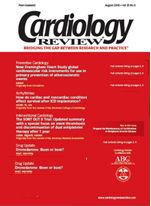Publication
Article
Cardiology Review® Online
Fondaparinux safer than standard antithrombotic therapy in ACS
Acute coronary syndrome
Stockholm—The antithrombotic fondaparinux (Arixtra) is as effective as enoxaparin (Lovenox) in preventing death, myocardial infarction (MI), and refractory ischemia while reducing the incidence
of bleeding over the first 9 days in patients with acute coronary syndromes (ACS) without ST elevation. As a result of
the reduction in bleeding, fondaparinux was associated with improved survival
at 30 days and 6 months compared with enoxaparin, said investigators at the
2005 Congress of the European Society of Cardiology.
With these findings from the Organization to Assess Strategies for Ischaemic Syndromes (OASIS-5) trial, fondaparinux should be considered the preferred anticoagulant in patients with ACS who are already receiving aspirin and clopidogrel (Plavix), said Salim Yusuf, MBBS, PhD, lead investigator of the trial. He noted that previous studies have already shown superiority of fondaparinux over enoxaparin in preventing deep vein thrombosis in patients undergoing various orthopedic surgeries.
OASIS-5 included 20,078 patients with ACS from 41 countries who were randomly assigned to receive fondaparinux, 2.5 mg/day, or enoxaparin, 1 mg/kg twice daily, for 2 to 8 days. The study medications were administered in addition to standard medical care including aspirin, clopidogrel, glycoprotein IIb/IIIa inhibitors, and revascularization procedures.
The primary objective was to evaluate whether fondaparinux was at least as effective as enoxaparin in preventing death, MI, or refractory ischemia. Secondary objectives included evaluation of safety (bleeding events) up to day 9, as well as determining if the relative effect of fondaparinux versus enoxaparin on the primary end point was sustained up to 6 months.
At 9 days, 5.9% of fondaparinux recipients and 5.8% of enoxaparin recipients experienced the primary end point, which met the criterion for noninferiority of fondaparinux. Furthermore, fondaparinux was associated with a 47% reduction in major bleeding versus enoxaparin (2.1% and 4.0%, respectively; P < .001).
Thirty-day mortality was 2.9% in the fondaparinux group and 3.5% in the enoxaparin group—a 17% reduction (P = .0219) in favor of fondaparinux. This reduction in mortality was maintained at 6 months (5.8% versus 6.6%; P = .037).
The reduction in mortality at 30 days with fondaparinux was a direct result of the reduction in bleeding with this agent, said Dr. Yusuf, professor of medicine and director of the Population Health Research Institute, McMaster University and Hamilton Health Sciences, Hamilton, Ontario, Canada. Patients who experience a major bleed in ACS are known to have a much higher risk of death during the immediate weeks following the event. “We know that major bleeding increases the risk of mortality independently by 400%,” he said.
The risk of major bleeding at 6 months was 28% lower in the fondaparinux group compared with the enoxapain group
(P < .001). Accordingly, the composite of death, MI, refractory ischemia, and bleeding at 6 months was 13% lower with
fondaparinux compared with enoxaparin (P < .001). Eighty-five percent of the difference in mortality between the treatment groups at 6 months was owing to the difference in the incidence of major bleeding.
The benefit of fondaparinux was apparent in hospitals with or without catheterization labs and whether or not patients received unfractionated heparin. “Put in context, our results showed that if you took 1,000 people with ACS and treated them with fondaparinux instead of enoxaparin, you would prevent 10 deaths from MI, 4 from stroke, and 25 major bleeds,” said Dr. Yusuf.
